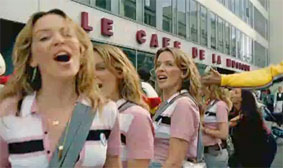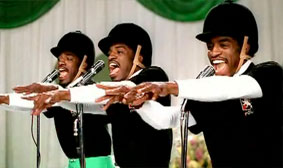Technical Question
I've always wanted to know how exactly mutliple motion control passess are fused together.
Are changing / moving figures and objects rotoscoped and composited or is there software that automaticaly figures out the difference between the layers and merges them together.
If rotoscoping was the case, i just cant even comprehend how it would have been done on Kylies video. There are literally dozens of moving elements.
Hope this makes sense?
Two examples below:
 Kylie - Come Into My World
Kylie - Come Into My World
and to a lesser extent
 Outkast - Hey Yah
Outkast - Hey Yah
Sharpie.. yes a little roto and flame work is common. However, the idea with moco is that the camera movement is entirely programmed. Hence, each pass is identical which regards to background and camera movement. The performer is placed in a different position in each pass. Depending on the desired effect heavy roto may not be necessary at all. What makes the Kylie video so complex is that she is crossing her own path. You can bet your ass that they composited and cleaned that up in a flame. I am making it seem much less complex, but it truly is the same principal as replacement animation (one of the oldest film FX).
Just for more mind boggling: I always wondered if Moco was used on this Feeder video by Davild Mould. I could swear that it is mostly doubles and mirrors: www.youtube.com
(sorry for the shit youtube)
the feeder vid is all doubles and in-camera. this was the first video after their drummer sadly committed suicide, hence his absence...
So I'm still not getting how they overlay (mainly because the sum total of my fx knowledge stops at basic compositing) - especially in the Kylie video.
Was there a portable greenscreen/bluescreen behind her each time so she could be composited easily? I get how the background was done, and I understand the principle of moco (although never had the budget to do it myself) but huh. Still a bit stumped.
For the Kylie Minogue video, they shot all of the passes with a motion control rig, so each time she walks a little bit differently and the background action is a bit different, and then they stack all of the different layers and essentially roto the parts that differ. They probably shoot a clean background pass for safety and cleanup, but each pass they shoot also has the background in it. If two versions of her are just walking, then a rough mask would be fine because they never touch and the background is the same, so cutting a hole in it just reveals an identical background below. It's almost like a split screen, but the identical passes make the split seem invisible. It gets tricky when she passes behind herself, in which case articulate roto is required that follows her motion perfectly. The same goes for each background element that differs, adding to the complications further. The motion capture rig just repeats passes identically, but there's not a way for it or software to tell the difference between the passes and separate out the elements (at least with good results). It all has to be done the tough way. Someone correct me if I'm out of wack here... —graham
There is also the theory of the difference matte. Its a filter that analyzes what is different on composited shots and cuts them out. So if you have a shot with matching BG and a different element in the foreground, it tries to make a matte based on what is different. I have never really got it to work but I eat pizza every day so my brain is filled with cheese.
To non-VFX people the difference matte becomes some kind of hot button, one stop solution in their minds but it's not. I hear people talk in the same way about a luminance key.
Think of it this way: The difference matte analyses on a per pixel basis. So if you have an actor walk in front of a red background wearing a shirt with the same exact values of red, the filter will not generate a matte for that area of the image. It only generates a matte for the areas that are uniquely different and this works on a sliding scale. In other words you can get areas in your matte that are grey rather than white and sometimes if it is too similar it can be very noisy. Of course the parameters can be adjusted but your edges should always be of the most concern and often they suffer when you choke the matte, blur it, etc.
A compositor can use different techniques to build a more complete hold-out matte by combining keys, difference mattes, roto, etc. This is why moco is so great because like some of the previous posters pointed out, you should do a clean pass, and then several other passes such as background only, hero in front of green screen , etc. The moral of the story is that if you want to shoot effects like this Kylie video expect to spend the money or be patient with a favor.
Hmm. So i take it that there is no miracle one button option.
Its just insane to think how much roto they would have done on it.
If you look deep into the clip, just to think how much would have been done on the stretch where she walks underneath a row of ladders, with a cloned extra climbing up and down each ladder.
They must have had an army of good flame operators on this.
Another thought, it seems they could have actually filmed multiple extras in identicle wardrobe as you cant quite always see their faces ie, wearing helmets, facing away from camera.
I know that you get good mocos and bad ones, even with the better ones, do you ever get sync/timing problems or are they pretty much 100% reliable?
Also, can anyone say what lense would they have used to get everything in focus? fore/mid/back
also how could they have avoided getting people from different passes into each other's spaces? the extra kylies as well as all the people on bikes and ladders and etc etc -- if they did cross into each other space/time could the flame fix that or was it that perfectly well choreographed?
it makes me anxious just thinking about that level of organization.
adam egypt mortimer:
I guess they did a lot of passes without taking care of who stepped into who. then in the editing they sorted the takes to avoid people from walking into themselves.
I suppose they had something like a 40 videolayer-timeline (multiple layers for each person) which was then composited in flame.
That's what's so unique about Michel Gondry. He uses digital tools (flame, mattes, etc) to support "in camera"-stuff (what motion control is, in my opinion). And often, as in this case, he pushes the techonolgy to the edge.
one more thing..
when you watch the pack shot of a beer commercial, it's pretty much the same. they use motion control to do multiples passes of the product (one for the fluid, one for the branding, one for the bottle) and composite them together.
hey, if you thought that was complex....
Motion control seems so easy in theory. Thats why one fateful day i tried it out. It took about 7 hours to do 3 shots. The motion control technicians were working off some archaic software on an old pc. They were plotting key frames in a timeline for movement and focus. This seemed completely simple to me but still it took 1 and half hours to setup for one very simple motion control shot. Anyway to make a long story short i ended up having to shoot the rest of the video in about 4 hours. The video turned out terrible because i was told by the technicians that the motion control shots would only take 2 hours. 7 hours later i had grey hair and was ready to strangle the technicians. Motion control is the pits unless you have the cash to dedicate the time that it requires.
Paul MCcartney and ever present past has a simular effect but i cant tell if they are the same woman or very good doubles
And the making of the video....
if you watch the making of, it tells you!
Might be an idea i guess ;)
kansas:
there are different motion control tools on the market. I was involved in a shooting where the dop did the move himself, by hand. this was "recorded" by the tripod and later done by machine again and again. they did that movement again a few days later on a different set to compose the pictures.
